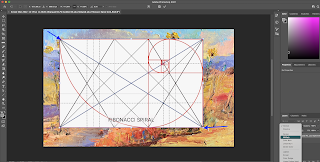2022 Booklet of Paintings with Grid Transparencies

I spent some time recently creating this very small 4x5 booklet of some of my paintings with Vista Print. I wanted to illustrate how one might analyze paintings using grids just as historic artists might have used. I made transparencies of various grids to be superimposed over the paintings with a ratio of 3:4 (9x12, 12z16 and 18x24). Here's an illustration from the book, but have a look at the transparencies in this post below. The transparencies are not permanently in place. This allows the viewer to mix and match transparencies. One idea would be to see if any particular grid is more effective. You might want to read the posts on applying the grids to other paintings; eg, my post on Design Armature Examples applied to the Santa Fe River Turbulence ). I go into detail about the different grids including the Andrew Loomis' Informal Subdivision. But I will make a few descriptive comments here also. You may also search through this blog using the search bar above. Alterna


